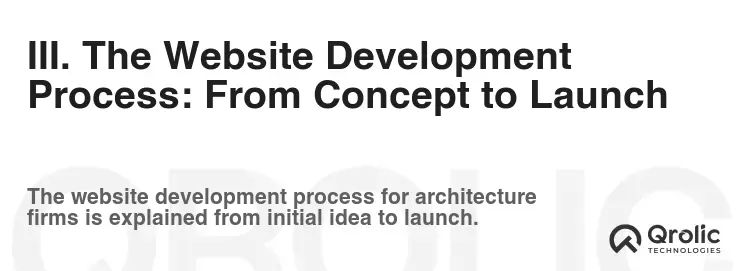Quick Summary:
- Your website is your firm’s crucial digital storefront.
- Showcase projects with stunning visuals and clear details.
- Optimize for search and use calls to action to get leads.
- Choose a skilled web partner for long-term success.
Table of Contents
- Website Development for Architecture Firms: Building a Digital Masterpiece
- I. The Architect’s Digital Blueprint: Why Your Website Matters
- A. First Impressions and Credibility: The Digital Handshake
- B. Showcasing Your Portfolio: A Visual Testament to Your Expertise
- C. Lead Generation and Client Acquisition: Turning Visitors into Clients
- D. Establishing Your Brand Identity: Communicating Your Unique Value
- E. Search Engine Optimization (SEO): Getting Found Online
- II. Essential Elements of an Effective Architecture Firm Website
- A. Stunning Visuals: Captivating Your Audience
- B. Compelling Portfolio: Showcasing Your Best Work
- C. Clear and Concise Messaging: Communicating Your Value Proposition
- D. User-Friendly Navigation: Ensuring a Seamless Experience
- E. Strong Calls to Action: Guiding Visitors Towards Conversion
- F. Blog and Resources: Establishing Thought Leadership
- III. The Website Development Process: From Concept to Launch
- A. Planning and Strategy: Defining Your Goals and Target Audience
- B. Design and Development: Bringing Your Vision to Life
- C. Content Creation: Crafting Compelling and Engaging Content
- D. Testing and Optimization: Ensuring a Flawless User Experience
- E. Launch and Promotion: Getting Your Website in Front of the World
- IV. SEO Strategies for Architecture Firms: Ranking Higher in Search Results
- A. Keyword Research: Identifying Relevant Search Terms
- B. On-Page Optimization: Optimizing Your Website’s Content and Structure
- C. Off-Page Optimization: Building Authority and Credibility
- D. Local SEO: Attracting Local Clients
- E. Mobile Optimization: Ensuring a Mobile-Friendly Experience
- V. Choosing the Right Website Development Partner
- A. Experience and Expertise: Look for a Proven Track Record
- B. Understanding of the Architecture Industry: Find a Partner Who “Gets” You
- C. Communication and Collaboration: Ensuring a Smooth Workflow
- D. Cost and Value: Finding the Right Balance
- E. Ongoing Support and Maintenance: Ensuring Long-Term Success
- VI. Qrolic Technologies: Your Partner in Building a Digital Legacy
- VII. Conclusion: Building Your Digital Future
- VIII. Future Trends in Architecture Website Development
- A. Artificial Intelligence (AI): Enhancing User Experience and Efficiency
- B. Virtual Reality (VR) and Augmented Reality (AR): Immersive Experiences
- C. Sustainability and Accessibility: Designing for a Better Future
- D. Data-Driven Design: Making Informed Decisions
Website Development for Architecture Firms: Building a Digital Masterpiece
Architecture firms, renowned for shaping the physical world, often overlook the crucial role of a well-crafted online presence. In today’s digital age, your website is your firm’s digital storefront, first impression, and lead generation engine. A compelling website isn’t just a nice-to-have; it’s a necessity for attracting clients, showcasing your portfolio, and establishing your brand as a leader in the architectural landscape. This comprehensive guide delves into every aspect of website development for architecture firms, equipping you with the knowledge to build a digital masterpiece that reflects your firm’s vision and expertise.
I. The Architect’s Digital Blueprint: Why Your Website Matters

Before diving into the technicalities, let’s address the fundamental question: Why is a website crucial for architecture firms?
A. First Impressions and Credibility: The Digital Handshake
In the digital age, potential clients often begin their search for an architect online. Your website is often the first point of contact, and first impressions matter immensely. A professionally designed, visually appealing, and user-friendly website instantly builds credibility and trust.
- Visual Appeal: A website reflecting the firm’s aesthetic, with high-quality images and videos, conveys professionalism and attention to detail.
- Clear Messaging: A concise and compelling narrative about your firm’s values, expertise, and unique selling proposition (USP) resonates with potential clients.
- Professional Design: A well-structured and intuitive website design demonstrates competence and a commitment to user experience.
B. Showcasing Your Portfolio: A Visual Testament to Your Expertise
Your portfolio is the cornerstone of your architectural firm. Your website provides the perfect platform to showcase your best work in a visually stunning and easily accessible format.
- High-Quality Imagery: Use professional photographs and videos to highlight the details and nuances of your projects. Showcase different angles, interior and exterior views, and even before-and-after comparisons.
- Project Descriptions: Provide detailed descriptions of each project, including the client’s brief, the design challenges, the solutions you implemented, and the project’s impact.
- Categorization and Filtering: Organize your portfolio into categories (e.g., residential, commercial, institutional) and allow users to filter projects based on keywords, location, or project type. This makes it easy for potential clients to find relevant examples of your work.
C. Lead Generation and Client Acquisition: Turning Visitors into Clients
Your website should be more than just a brochure; it should be a lead generation engine. By strategically implementing calls to action (CTAs) and lead capture forms, you can convert website visitors into qualified leads.
- Contact Forms: Make it easy for potential clients to contact you by including prominently placed contact forms throughout your website.
- Calls to Action (CTAs): Use compelling CTAs to encourage visitors to take specific actions, such as “Download Our Brochure,” “Request a Consultation,” or “View Our Portfolio.”
- Blog and Resources: Create valuable content, such as blog posts, articles, and case studies, to attract potential clients and establish your firm as a thought leader in the industry. Offer gated content (e.g., a white paper) in exchange for contact information.
D. Establishing Your Brand Identity: Communicating Your Unique Value
Your website is a powerful tool for shaping your brand identity and communicating your unique value proposition to the world.
- Consistent Branding: Ensure that your website’s design, imagery, and messaging are consistent with your overall brand identity.
- Unique Selling Proposition (USP): Clearly articulate what makes your firm different from the competition. What are your core values? What are your areas of expertise? What is your design philosophy?
- Testimonials and Awards: Showcase testimonials from satisfied clients and any awards or recognition your firm has received to build trust and credibility.
E. Search Engine Optimization (SEO): Getting Found Online
Having a beautiful website is useless if no one can find it. Search engine optimization (SEO) is the process of optimizing your website to rank higher in search engine results pages (SERPs) for relevant keywords.
- Keyword Research: Identify the keywords that potential clients are using to search for architects in your area. Keywords like “architecture website development”, “design firm web design”, and “architect website services” are crucial.
- On-Page Optimization: Optimize your website’s content, meta tags, and URL structure for your target keywords.
- Off-Page Optimization: Build backlinks from other reputable websites to increase your website’s authority and credibility.
- Local SEO: Optimize your website for local search to attract clients in your geographic area.
II. Essential Elements of an Effective Architecture Firm Website

Now that you understand why a website is crucial, let’s explore the essential elements that make up an effective architecture firm website.
A. Stunning Visuals: Captivating Your Audience
As an architecture firm, visuals are paramount. Your website should showcase high-quality photographs and videos of your projects.
- Professional Photography: Invest in professional photography to capture the beauty and detail of your work.
- High-Resolution Images: Use high-resolution images that are optimized for web viewing.
- Video Content: Incorporate video content, such as project walkthroughs, client testimonials, and interviews with your team.
- Image Galleries: Create visually appealing image galleries to showcase multiple images of each project.
B. Compelling Portfolio: Showcasing Your Best Work
Your portfolio is the centerpiece of your website. It should be well-organized, easy to navigate, and visually appealing.
- Project Organization: Categorize your projects by type (e.g., residential, commercial, institutional) or style (e.g., modern, traditional, sustainable).
- Detailed Project Pages: Create individual pages for each project that include high-quality images, detailed descriptions, and client testimonials.
- Interactive Elements: Consider incorporating interactive elements, such as 3D models or virtual tours, to enhance the user experience.
- Before-and-After Comparisons: Showcase the transformative power of your designs by including before-and-after comparisons.
C. Clear and Concise Messaging: Communicating Your Value Proposition
Your website should clearly communicate your firm’s values, expertise, and unique selling proposition.
- About Us Page: Tell your firm’s story, highlighting your mission, vision, and values.
- Services Page: Clearly outline the services you offer, such as architectural design, interior design, landscape architecture, and project management.
- Team Page: Introduce your team members, highlighting their expertise and experience.
- Case Studies: Share detailed case studies that demonstrate your ability to solve complex design challenges.
D. User-Friendly Navigation: Ensuring a Seamless Experience
Your website should be easy to navigate and user-friendly.
- Intuitive Menu Structure: Use a clear and concise menu structure that allows users to easily find the information they need.
- Mobile-Responsive Design: Ensure that your website is responsive and looks great on all devices, including desktops, laptops, tablets, and smartphones.
- Fast Loading Speed: Optimize your website for speed to ensure a smooth and seamless user experience.
- Clear Calls to Action: Use clear and compelling calls to action to guide users through your website and encourage them to take specific actions.
E. Strong Calls to Action: Guiding Visitors Towards Conversion
Guide your website visitors toward becoming leads and clients with strategically placed and compelling calls to action (CTAs).
- “Contact Us” Buttons: Prominently display “Contact Us” buttons on every page of your website.
- “Request a Consultation” Forms: Offer visitors the opportunity to request a free consultation.
- “Download Our Brochure” Offers: Provide visitors with a downloadable brochure that showcases your firm’s capabilities.
- “View Our Portfolio” Links: Direct visitors to your portfolio to showcase your best work.
F. Blog and Resources: Establishing Thought Leadership
Creating a blog and resource section on your website allows you to share your expertise, attract potential clients, and improve your SEO.
- Informative Blog Posts: Publish blog posts on topics relevant to your target audience, such as design trends, sustainable architecture, and project management tips.
- Case Studies: Share detailed case studies that demonstrate your ability to solve complex design challenges.
- White Papers and Ebooks: Offer downloadable white papers and ebooks on topics of interest to potential clients.
- News and Updates: Share news and updates about your firm, such as new projects, awards, and events.
III. The Website Development Process: From Concept to Launch

Developing a website for your architecture firm is a multifaceted process that requires careful planning and execution. Here’s a step-by-step guide to the website development process:
A. Planning and Strategy: Defining Your Goals and Target Audience
Before you start designing your website, it’s essential to define your goals and target audience.
- Define Your Goals: What do you want to achieve with your website? Do you want to generate leads, showcase your portfolio, or establish your brand as a thought leader?
- Identify Your Target Audience: Who are you trying to reach with your website? What are their needs and interests?
- Conduct Competitor Research: Analyze your competitors’ websites to identify their strengths and weaknesses.
- Develop a Content Strategy: Plan the content you will include on your website, such as text, images, and videos.
- Create a Sitemap: Develop a sitemap that outlines the structure of your website and the relationships between different pages.
B. Design and Development: Bringing Your Vision to Life
Once you have a solid plan in place, you can start designing and developing your website.
- Choose a Domain Name: Select a domain name that is relevant to your firm and easy to remember.
- Select a Web Hosting Provider: Choose a reliable web hosting provider that offers the features and support you need.
- Choose a Content Management System (CMS): Select a CMS, such as wordpress, that allows you to easily manage and update your website’s content.
- Design the Website Layout: Create a visually appealing and user-friendly website layout that reflects your brand identity.
- Develop the Website Functionality: Develop the website’s functionality, such as contact forms, portfolio galleries, and blog features.
- Ensure Mobile Responsiveness: Make sure that your website is responsive and looks great on all devices.
C. Content Creation: Crafting Compelling and Engaging Content
High-quality content is essential for attracting visitors and converting them into leads.
- Write Compelling Copy: Write clear, concise, and engaging copy that communicates your firm’s value proposition.
- Optimize Content for SEO: Optimize your content for relevant keywords to improve your website’s search engine ranking.
- Use High-Quality Images and Videos: Use professional photographs and videos to showcase your work.
- Create Case Studies: Share detailed case studies that demonstrate your ability to solve complex design challenges.
- Write Blog Posts: Publish blog posts on topics relevant to your target audience.
D. Testing and Optimization: Ensuring a Flawless User Experience
Before launching your website, it’s essential to test it thoroughly to ensure a flawless user experience.
- Test Website Functionality: Test all website functionality, such as contact forms, portfolio galleries, and blog features.
- Check for Broken Links: Ensure that all links on your website are working properly.
- Test Website Responsiveness: Test your website on different devices to ensure that it is responsive.
- Check Website Speed: Optimize your website for speed to ensure a smooth and seamless user experience.
- Gather Feedback: Ask colleagues and friends to provide feedback on your website’s design and functionality.
E. Launch and Promotion: Getting Your Website in Front of the World
Once you have tested and optimized your website, you can launch it to the world.
- Submit Your Website to Search Engines: Submit your website to Google and other search engines.
- Promote Your Website on Social Media: Share your website on social media platforms such as LinkedIn, Facebook, and Instagram.
- Email Marketing: Send email newsletters to your subscribers to promote your website and new content.
- Online Advertising: Consider running online advertising campaigns to drive traffic to your website.
- Networking: Share your website with your professional network.
IV. SEO Strategies for Architecture Firms: Ranking Higher in Search Results

Search engine optimization (SEO) is crucial for attracting potential clients to your website. Here are some effective SEO strategies for architecture firms:
A. Keyword Research: Identifying Relevant Search Terms
Keyword research is the foundation of any successful SEO strategy.
- Identify Relevant Keywords: Use keyword research tools, such as Google Keyword Planner and SEMrush, to identify the keywords that potential clients are using to search for architects in your area. Examples of keywords are “architecture website development”, “design firm web design”, and “architect website services”.
- Focus on Long-Tail Keywords: Target long-tail keywords, which are longer and more specific search terms, to attract a more qualified audience.
- Analyze Competitor Keywords: Analyze the keywords that your competitors are targeting to identify opportunities for improvement.
B. On-Page Optimization: Optimizing Your Website’s Content and Structure
On-page optimization involves optimizing your website’s content and structure to improve its search engine ranking.
- Optimize Title Tags and Meta Descriptions: Write compelling title tags and meta descriptions that accurately describe your website’s content and include your target keywords.
- Use Header Tags (H1-H6): Use header tags to structure your content and make it easier for search engines to understand.
- Optimize Image Alt Tags: Add descriptive alt tags to your images that include your target keywords.
- Use Internal Linking: Link to other relevant pages on your website to improve its overall structure and navigation.
- Create High-Quality Content: Create informative, engaging, and well-written content that satisfies the needs of your target audience.
C. Off-Page Optimization: Building Authority and Credibility
Off-page optimization involves building your website’s authority and credibility by earning backlinks from other reputable websites.
- Build High-Quality Backlinks: Earn backlinks from other reputable websites in your industry, such as architecture blogs, online publications, and industry directories.
- Guest Blogging: Write guest posts for other websites in your industry to build backlinks and reach a wider audience.
- Social Media Marketing: Share your website’s content on social media platforms to increase its visibility and attract backlinks.
- Online Directory Listings: List your website in relevant online directories.
D. Local SEO: Attracting Local Clients
Local SEO is crucial for attracting clients in your geographic area.
- Claim Your Google My Business Listing: Claim and optimize your Google My Business listing to improve your visibility in local search results.
- Use Local Keywords: Use local keywords, such as “architect in [your city],” in your website’s content and meta tags.
- Get Local Citations: List your website in local online directories, such as Yelp and Yellow Pages.
- Encourage Customer Reviews: Encourage satisfied clients to leave reviews on your Google My Business listing and other review platforms.
E. Mobile Optimization: Ensuring a Mobile-Friendly Experience
With the increasing use of mobile devices, it’s essential to ensure that your website is mobile-friendly.
- Use a Responsive Design: Use a responsive design that adapts to different screen sizes.
- Optimize Website Speed: Optimize your website for speed to ensure a smooth and seamless user experience on mobile devices.
- Use Large Fonts and Buttons: Use large fonts and buttons that are easy to read and tap on mobile devices.
- Simplify Navigation: Simplify your website’s navigation to make it easy for mobile users to find the information they need.
V. Choosing the Right Website Development Partner

Developing a website for your architecture firm is a significant investment. Choosing the right website development partner is crucial for ensuring a successful outcome.
A. Experience and Expertise: Look for a Proven Track Record
Choose a website development partner with experience in building websites for architecture firms.
- Review Their Portfolio: Review their portfolio to see examples of their previous work.
- Ask for References: Ask for references from their previous clients.
- Assess Their Expertise: Assess their expertise in website design, development, and SEO.
- Inquire about their team: Understand the team’s skills and experience in relevant areas.
B. Understanding of the Architecture Industry: Find a Partner Who “Gets” You
Select a partner who understands the unique needs and challenges of the architecture industry.
- Industry Knowledge: Look for a partner who has a deep understanding of the architecture industry.
- Design Sensibility: Find a partner who understands the importance of visual aesthetics in architecture.
- Target Audience Understanding: Ensure the partner understands your target audience and their needs.
- Brand Alignment: They should be able to translate your firm’s brand identity into the digital space.
C. Communication and Collaboration: Ensuring a Smooth Workflow
Choose a partner who communicates effectively and collaborates closely with you throughout the website development process.
- Clear Communication: Ensure they communicate clearly and regularly.
- Collaborative Approach: Look for a partner who values your input and works collaboratively with you.
- Project Management: Inquire about their project management process and how they ensure projects are completed on time and within budget.
- Feedback Integration: They should be receptive to your feedback and willing to make adjustments as needed.
D. Cost and Value: Finding the Right Balance
Consider the cost of website development, but don’t sacrifice quality for price.
- Get Multiple Quotes: Get quotes from multiple website development partners.
- Compare Proposals: Compare the proposals carefully, paying attention to the scope of work, deliverables, and pricing.
- Consider the Long-Term Value: Consider the long-term value of the website, not just the initial cost.
- Hidden Costs: Ask about any potential hidden costs, such as ongoing maintenance or support fees.
E. Ongoing Support and Maintenance: Ensuring Long-Term Success
Choose a partner who provides ongoing support and maintenance to ensure the long-term success of your website.
- Technical Support: Ensure they offer technical support in case of any issues.
- Content Updates: Ask about their content update services.
- Security Updates: They should provide regular security updates to protect your website from threats.
- Website Monitoring: Inquire about their website monitoring services to ensure your website is always up and running.
VI. Qrolic Technologies: Your Partner in Building a Digital Legacy

At Qrolic Technologies (https://qrolic.com/), we understand the unique needs of architecture firms and are dedicated to crafting exceptional websites that reflect your firm’s vision and expertise. We combine cutting-edge technology with a deep understanding of design principles to deliver websites that are visually stunning, user-friendly, and highly effective at generating leads.
Why Choose Qrolic Technologies?
- Expertise in Architecture Website Development: We have a proven track record of building successful websites for architecture firms of all sizes.
- Custom Design Solutions: We create custom website designs that are tailored to your firm’s brand and target audience.
- SEO Optimization: We implement effective SEO strategies to ensure that your website ranks high in search engine results.
- Mobile-Responsive Design: We ensure that your website is mobile-responsive and looks great on all devices.
- Ongoing Support and Maintenance: We provide ongoing support and maintenance to ensure the long-term success of your website.
Let Qrolic Technologies help you build a digital legacy that showcases your architectural masterpieces and attracts new clients. Contact us today for a free consultation.
VII. Conclusion: Building Your Digital Future

In today’s competitive landscape, a well-designed and optimized website is no longer optional for architecture firms – it’s essential. By understanding the key elements of an effective architecture firm website, implementing effective SEO strategies, and choosing the right website development partner, you can build a digital masterpiece that reflects your firm’s vision and attracts new clients. Your website is an investment in your firm’s future, and with careful planning and execution, it can become a powerful engine for growth and success. Embrace the digital realm and build a website that truly represents the excellence of your architectural firm. This is your opportunity to design not just buildings, but your digital presence.
VIII. Future Trends in Architecture Website Development

The digital landscape is constantly evolving, and it’s important to stay ahead of the curve. Here are some future trends in architecture website development to keep in mind:
A. Artificial Intelligence (AI): Enhancing User Experience and Efficiency
AI is poised to revolutionize website development, offering new ways to enhance user experience and streamline operations.
- AI-Powered Chatbots: Implement AI-powered chatbots to provide instant customer support and answer frequently asked questions.
- Personalized Content: Use AI to personalize website content based on user behavior and preferences.
- Automated SEO: Utilize AI-powered SEO tools to automate keyword research, content optimization, and link building.
- Predictive Analytics: Use AI to predict user behavior and optimize website design and content accordingly.
B. Virtual Reality (VR) and Augmented Reality (AR): Immersive Experiences
VR and AR technologies offer new ways to showcase architectural designs and provide immersive experiences for potential clients.
- Virtual Tours: Create virtual tours of your projects that allow users to explore the spaces in a realistic and interactive way.
- Augmented Reality Overlays: Use AR to overlay digital models of your designs onto real-world environments.
- Interactive 3D Models: Allow users to interact with 3D models of your designs and customize them to their liking.
- Immersive Presentations: Use VR and AR to create immersive presentations that showcase your firm’s capabilities and design philosophy.
C. Sustainability and Accessibility: Designing for a Better Future
Sustainability and accessibility are becoming increasingly important considerations in website development.
- Eco-Friendly Design: Design your website with sustainability in mind, using energy-efficient coding practices and minimizing resource consumption.
- Accessible Design: Ensure that your website is accessible to users with disabilities, following WCAG guidelines.
- Sustainable Content: Create content that promotes sustainable design practices and showcases your firm’s commitment to environmental responsibility.
- Inclusive Language: Use inclusive language that is respectful of all users.
D. Data-Driven Design: Making Informed Decisions
Data analytics provides valuable insights into user behavior and website performance.
- Track Website Traffic: Monitor your website’s traffic to identify popular pages and areas for improvement.
- Analyze User Behavior: Analyze user behavior to understand how visitors are interacting with your website and identify areas where they are struggling.
- A/B Testing: Use A/B testing to experiment with different design elements and content strategies to optimize your website’s performance.
- Personalized Experiences: Use data to personalize the user experience and provide tailored content and recommendations.
By embracing these future trends, architecture firms can create websites that are not only visually stunning and user-friendly but also technologically advanced and socially responsible. The future of architecture website development is bright, and by staying informed and adapting to change, you can ensure that your firm’s website remains a powerful tool for attracting clients and building a successful business.







